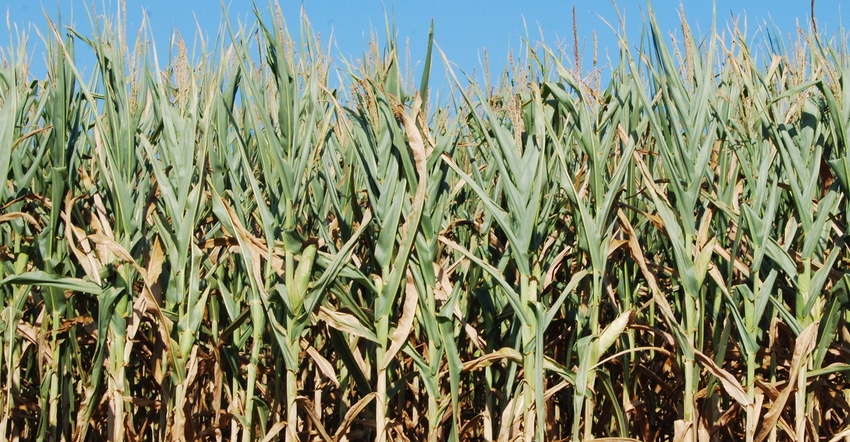August 10, 2020

Farmers attending a series of drought information meetings last week held across west-central and central Iowa say the deepening drought has reduced their corn yields significantly. And without timely rains in August, soybean yields will be further reduced. Also, pastures are scorched, requiring some livestock producers to haul water to cattle where ponds and creeks are drying up.
A total of 23 counties in west-central and central Iowa are experiencing extreme or severe drought, according to the U.S. Drought Monitor, which is updated weekly. Parts or all of 13 of those counties are now labeled as experiencing extreme drought. Rainfall for the year in west-central counties is 8 to 12 inches below normal, says Justin Glisan, state climatologist at the Iowa Department of Agriculture.
“When you do get rain, it’s been spotty, at best,” he says. “If you’re lucky, you may get a half-inch to an inch. But to really improve the situation, we need rainfall to come more consistently.” Speaking on the weekly Iowa State University drought information webinar on Aug. 6, Glisan says west-central Iowa is experiencing a “flash drought.”
High winds, hot temperatures and low humidity “took hold in June and produced high evapotranspiration. The dry, hot air pulls water vapor out of the soil,” he explains. “Then in July, it just quit raining. Conditions degraded rather fast. West-central Iowa went from abnormally dry to drought in about a month, with expansion every week.”
Drought reaching further into Iowa
Meanwhile, most of northern and eastern Iowa received rain in June. However, those areas are now classified as abnormally dry. Farmers in that part of Iowa say corn and soybean crops are becoming stressed.
The outlook for west-central Iowa is for warmer and wetter weather in August. Glisan says rain will likely continue to be spotty. “The cooler-than-normal temperatures we’ve had in Iowa during the first week of August helped the crops, reducing the amount of moisture the plants need,” he says. “But cooler temperatures aren’t a substitute for rain.”
In west central and parts of central Iowa, the leaves of corn plants have curled up to reduce moisture loss. They’ve also aborted the kernels at the ear tip, and the leaves at the bottom of the plants are “firing,” or turning yellow. “You get out into some of these fields and you find up to 30% of the kernels are missing on many of the ears,” says Mike Witt, ISU field agronomist in west-central Iowa.
It’s difficult to predict the extent of yield reduction, he notes. Some rain could still help fill out the kernels and help improve yields. Rain in August would also improve soybean yields, adding pods and beans in pods.
Will drought boost grain prices?
Unlike the widespread national drought that struck crops in 2012, this year’s dryness in western and central Iowa isn’t affecting corn and soybean prices — not yet, anyway. “That could change, if the drought becomes more severe and widespread,” says Chad Hart, ISU Extension grain marketing economist. “If the drought becomes big enough in Iowa, the nation’s largest corn-producing state, it will have national impact.”
The nation’s soybean crop in early August is rated 70% good to excellent, according to USDA’s weekly survey. And, farmers are expected to harvest the second-largest U.S. corn crop on record in 2020. With the prospect of big yields nationally, prices are down about 20% from where they started the year. For farmers in Iowa facing drought and low yields, that’s the worst situation — a bad crop and bad yields.
Depending on how much more intense and widespread the drought becomes, Hart says farmers could see a price rally in September, after USDA releases its monthly crop report based on in-the-field estimates. Improved exports of U.S. corn to China could also help boost prices, he says, as China recently announced it is buying corn. To learn more, visit Chad Hart’s latest Ag Market Outlook.
Iowa epicenter of droughty crops
Iowa’s crop conditions continue to be the worst among Midwest states. In addition to west-central and central Iowa, areas of northwest Iowa have also seen conditions deteriorate over the past month. Sac, Crawford and Calhoun counties are now classified as being in “extreme drought.” The corn crop there has smaller-than-normal ears.
ISU Extension agronomist Paul Kassel in northwest Iowa says the maturity of the corn in drought-hit fields will be sped up, leading to an early harvest and lower yields. “We’ll see some reduced yields here, but nationally, the corn crop looks pretty good,” he adds. “Crop ratings, subsoil moisture supplies and rainfall are favorable in other areas of the Upper Midwest. Unfortunately, for our farmers in these driest areas of Iowa, 2020 is going to mean lower yields and lower prices.”
“We’re going to see a lot of crop insurance claims in the driest areas this year,” Witt says.
Meaghan Anderson, ISU agronomist in central Iowa, says some cornfields she checked last week showed 20% yield losses. “We’ve already taken a fairly good chunk off the top of our corn yields,” she says. “Soybean yields still have some potential to improve, if we get rains in August.”
Aaron Saeugling, ISU Extension agronomist in southwest Iowa, says the driest fields in his area will likely average under 100 bushels of corn per acre this fall. “However, there are some areas of southwest Iowa where the crop looks pretty good,” he notes. “Along the Highway 34 corridor, for example, they’ve had some rain this summer that the other areas haven’t received.”
What about soybeans? “Once again, we’re playing the ‘if-it-could-only-rain game,’ and if we get timely rains in August, soybeans have the potential to fill those pods, add some bushels and catch up.” Saeugling says.
Find the latest Iowa weather and crop condition information.
You May Also Like




